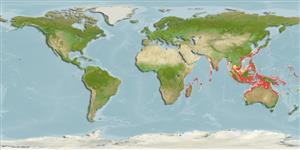>
Pleuronectiformes (Flatfishes) >
Bothidae (Lefteye flounders)
Etymology: Crossorhombus: Greek krossoi = tassel + Greek, rhombos = paralelogram (Ref. 45335).
More on author: Alcock.
Environment: milieu / climate zone / depth range / distribution range
Sinh thái học
Biển gần đáy; Mức độ sâu 13 - 60 m (Ref. 9824). Tropical
Indo-West Pacific: Bay of Bengal, northwestern Australia, South China Sea, China, Taiwan, Japan, Viet Nam, and Aru Islands, Indonesia.
Bộ gần gũi / Khối lượng (Trọng lượng) / Age
Maturity: Lm ? range ? - ? cm
Max length : 18.0 cm TL con đực/không giới tính; (Ref. 9824)
Các vây lưng mềm (tổng cộng) : 84 - 92; Tia mềm vây hậu môn: 63 - 74. Ground colour on eyed side brownish grey, with darker spots and blotches. Fins paler than body, dorsal and anal fins with small dark spots, caudal fin with 2 distinct dark bands. Males with small dark spots in anterior part of interorbital region. Blind side whitish in females. Males with distinct bluish black pyriform colour pattern on blind side. Body ovoid, its depth 1.7 to 2 times in SL. Head small, snout shorter than eye, profile steep anterior to interorbital area. Head length 3.3 to 4.5 times in SL. Interorbital region broad and concave, wider in males than females in specimens greater than about 6 cm SL. Males with a rostral spine and 1 to 3 low bony bumps around orbits. Both eyes on left side of head, front margin of upper eye slightly behind front margin of lower eye. Both eyes in males larger than about 6 cm SL with a flap on posterior area. Mouth small, reaching to or slightly beyond anterior margin of lower eye, length of upper jaw 3.1 to 4.3 times in head length. Teeth in upper jaw biserial, teeth of outer row more widely spaced than teeth of inner row; teeth in lower jaw uniserial. Gill rakers short and pointed. Scales on eyed side with long ctenii. Pectoral fin on eyed side with 11 to 14 rays, its length 1.3 to 1.6 times in head length in both sexes. Pectoral fin on blind side with 9 to 12 rays (Ref 42535).
Lives on mud bottoms and feeds on bottom-living animals (Ref. 9824). Sexually dimorphic characters develop at about 6 cm SL (Ref. 9824).
Life cycle and mating behavior
Maturities | Sự tái sinh sản | Spawnings | Egg(s) | Fecundities | Ấu trùng
Sainsbury, K.J., P.J. Kailola and G.G. Leyland, 1985. Continental shelf fishes of the northern and north-western Australia. An illustrated guide. CSIRO Division of Fisheries Research; Clouston & Hall and Peter Pownall Fisheries Information Service, Canberra, Australia. 375 p. (Ref. 3131)
IUCN Red List Status (Ref. 130435)
Threat to humans
Harmless
Human uses
Các nghề cá: không ích lợi (thú vị)
Các công cụ
Special reports
Download XML
Các nguồn internet
Estimates based on models
Preferred temperature (Ref.
123201): 23.6 - 28.8, mean 27.2 °C (based on 460 cells).
Phylogenetic diversity index (Ref.
82804): PD
50 = 0.5312 [Uniqueness, from 0.5 = low to 2.0 = high].
Bayesian length-weight: a=0.00912 (0.00408 - 0.02036), b=3.05 (2.87 - 3.23), in cm total length, based on LWR estimates for this (Sub)family-body shape (Ref.
93245).
Mức dinh dưỡng (Ref.
69278): 3.5 ±0.37 se; based on food items.
Thích nghi nhanh (Ref.
120179): Trung bình, thời gian nhân đôi của chủng quần tối thiểu là 1.4 - 4.4 năm (Preliminary K or Fecundity.).
Fishing Vulnerability (Ref.
59153): Low vulnerability (10 of 100).
